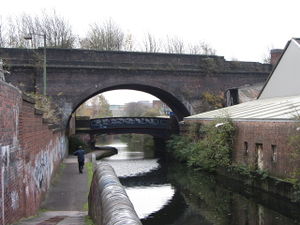Green Infrastructure 2014 Group I - Case Study 4
---> back to group page working group I
GREEN LINEAR STRUCTURES
| Name | Digbeth | |
| Country | UNITED KINGDOM | |
| City | Birmingham | |
| Authors | Ilona Feklistova | |

| ||
|
| ||
Rationale: Why is this case interesting?
Birmingham is a metropolitan district placed in West Midlands of England and is one of the most populous and densely built-up city in the Great Britain. Similarly to many other fast growing urban areas in the world Birmingham faces pressures from increase in population with its environmental and socioeconomic consequences. Along with that it goes through structural transformation where the service sector becomes the central for redevelopment of the city and regeneration of old industrial areas. Along with the number of abundant industrial buildings the wide spreading network of canals and railroad bear evidence of great industrial past when the city was called a "workshop of the World". These arteries were efficient transportation systems and catalytic for industrial past of the city. Today, partly abundant these widely spreading networks may have an essential value for improving green infrastructure especially due to their connection to rural areas. According to the report of local municipality Birmingham’s urban structure fails to fully respond to the demand of biodiversity, recreation and flood risk services, as well as mitigate effects of climate change. Thus I want to research if formal industrial infrastructure can increase the capacity of the city to create more resilient green network.
Author's perspective
I graduated with a Bachelor of Science Degree in Landscape Architecture and I had proceeded my studies in Estonian University of Life Sciences. At the moment I am working on my Master thesis that is explores Identity of Urban Allotments. Birmingham is an unfamiliar place for me. I have moved to UK because of the internship and I am staying in small town - Welshpool that is 86 km from the formal 'industrial heart' of UK - city of Birmingham. The amazing canal system that was developed in UK for transportation is absolutely a new element for me in a cultural landscape. Thus I am interested to explore it cultural-historical aspects and understand its potential for green infrastructure.
Landscape and/or urban context of your case
- Biogeography, cultural features, overall character, history and dynamics
- Illustrations: maps; sketches; short descriptive analyses
- Illustrations
- Yourimage.jpg
your visual
- Yourimage.jpg
your visual
- Yourimage.jpg
your visual
Analytical drawings
- Please use analytical drawing for visualising the conflicts/potentials of your site
- Analytical Drawings
- Your drawing.jpg
your drawing
- Your drawing.jpg
your drawing
- Your drawing.jpg
your drawing
- Your drawing.jpg
your drawing
Green Infrastructure benefits for this site
Look again at the multiple benefits of green infrastructure - what could be achieved in your site and which are most relevant?
Potential for multifunctionality
Green infrastructure has typically multiple functions. What could be achieved for your site in this respect?
Projective drawings
- How would you like this case to change in the near future? (in 1-2 years)
- you may add a short explanation here
- And how could it look like in 10-15 years?
- you may add a short explanation here
- Projective Drawings
- Yourdrawing.jpg
projective drawing
- Yourdrawing.jpg
projective drawing
- Yourdrawing.jpg
projective drawing
- Yourdrawing.jpg
projective drawing
Summary and conclusion
- 100 words approx.
Image Gallery
Please add further images/photos here
- Image Gallery
- Yourimage.jpg
your image text
- Yourimage.jpg
your image text
- Yourimage.jpg
your image text
- Yourimage.jpg
your image text
- Yourimage.jpg
your image text
- Yourimage.jpg
your image text
- Yourimage.jpg
your image text
- Yourimage.jpg
your image text
References
http://billdargue.jimdo.com/placenames-gazetteer-a-to-y/places-d/digbeth/ http://en.wikipedia.org/wiki/Birmingham_Canal_Navigations http://en.wikipedia.org/wiki/History_of_Birmingham#cite_note-240 http://www.birminghampost.co.uk/lifestyle/birmingham-city-council-bid-triple-6396846 www.birmingham.gov.uk/greenlivingspaces https://canalrivertrust.org.uk/canals-and-rivers/birmingham-canal-navigations http://www.birmingham.gov.uk/citycentrecanalcorridor https://www.google.com/maps/d/viewer?msa=0&mid=z8BscB1MtUUo.kusViGZdjOHg http://www.birmingham.gov.uk/greenlivingspaces
About categories: You can add more categories with this tag: "", add your categories